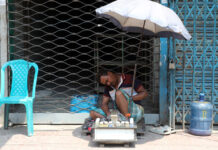Bomb disposal unit, explosives department suspect; experts won’t rule out gas from sewers as well

Accumulated gas was behind the massive explosion at the ground floor of a three-storey building in the capital’s Moghbazar on Sunday evening, said officials and experts.
At least six people were killed and 50 others injured in the blast that took place at the building on Outer Circular Road.
 For all latest news, follow The Daily Star’s Google News channel.
For all latest news, follow The Daily Star’s Google News channel.
Officials said they had confirmed that it was a gas explosion but are yet to identify the source, speculating that the gas could have accumulated from sewerage lines or leaking gas pipelines.
Visiting the spot where the blast is thought to have originated — a room of around 150 square feet behind the kitchen of a restaurant located on the ground floor – these correspondents found the ceiling in a semi-collapsed state.
The entire ground floor of the building was damaged and cracks developed throughout the floor of the building. The rear wall of the building was broken and also developed a crack.
Officials of Bangladesh Fire Service and Civil Defence (BFSCD) and Bomb Disposal Unit (BDU) of Dhaka Metropolitan Police (DMP) in their primary assessment found that gas had accumulated in the room and was ignited by a spark, causing the explosion.
BDU officials said they primarily suspect that gas leaked from a pipeline and an electric spark or someone lighting a flame ignited the gas and caused the catastrophic explosion.
Requesting anonymity, a senior BDU official involved with the investigation told The Daily Star that they detected inside the building an odour of hydrocarbon gas like natural gas or methane, which accrued from a gas pipeline in the building.
Experts and officials also ruled out explosion of air conditioner or gas cylinder as causes for the huge blast.
“The cylinder found in the building was intact and it is clearly assumed that it was not the source of the amassed gas,” said the official, adding that they had not found any proof of an AC explosion.
Titas Gas Transmission and Distribution Company Ltd (TGTDCL) authorities, however, blamed a cylinder blast.
“The explosion was from a cylinder blast and the owner of the building is not a consumer of Titas gas,” Ali Iqbal Md Nurullah, managing director of TGTDCL, said.
Contrary to the Titas statement, officials of Department of Explosives, fire service and BDU found gas pipeline connections in the building.
“We have found gas line connection on the second and third floors of the building and gas was still found coming out even after the explosion,” said an official of the Department of Explosives.
No case was filed till around 6:00pm yesterday in this connection.
“We are looking for the building owner Khokon to get details of utility connections but he is on the run after the incident,” said Monirul Islam, officer-in-charge of Ramna Police station.
CAUSE OF THE EXPLOSION?
Brig Gen Md Sazzad Hussain, director general of BFSCD, said they are primarily suspecting that the explosion took place due to accumulation of gas.
“We found the presence of gases including hydrogen sulfide, phosgene and methane. These gases are produced from waste, especially human waste. Sewerage line can be a probable source of the blast,” he said.
The DG also said they are trying to identify the sources of the blast and also the sewerage network connected to the building.
“We have collected evidence and after analysing the evidence we can say exactly what the source of the explosion was.”
Echoing Sazzad’s statement, former DG of BFSCD Brigadier General (retd) Ali Ahmed Khan said the building was old and there was no ventilation system in the room.
“We found a manhole cover and leaked gas pipelines in the room. These two made the room into a gas chamber. After 14 hours of the accident, we found the presence of methane gas to be around nine percent. That gas ignited somehow and caused the huge blast,” Ahmed, president of Safety Awareness Foundation, said.
Abul Kalam Azad, chief explosive inspector of Department of Explosives, said they have found presence of hydrocarbon in the debris. Presence of hydrocarbon gas of 5 to 18 percent is enough for explosion, he said.
Echoing Azad, Buet’s Associate Professor of Department of Chemical Engineering Dr Md Easir Arafat Khan said usually there should not be a huge amount of hydrogen sulfide and phosgene gas but those gases can accumulate inside a small room from sewerage and drainage lines.
“But if methane gas also accumulated in a confined room from leakage of natural gas pipelines, then such type of explosion can take place. These three gases altogether can cause such a devastating explosion. However, we have to identify the sources of the gases,” he said.
PROBE COMMITTEES
Department of Explosives have formed a three-member probe body with the deputy chief explosive inspector as its chief. The committee will submit a report within seven working days.
Meanwhile, Bangladesh police have also formed a seven-member committee headed by additional commissioner of Counter Terrorism and Transnational Crime (CTTC) unit to investigate the Moghbazar explosion. The committee will submit the report within seven working days.
Answering a query about whether it was an act of sabotage, after visiting the spot Inspector General of Police Benazir Ahmed told journalists that they have to wait a day or two for experts’ opinion.











